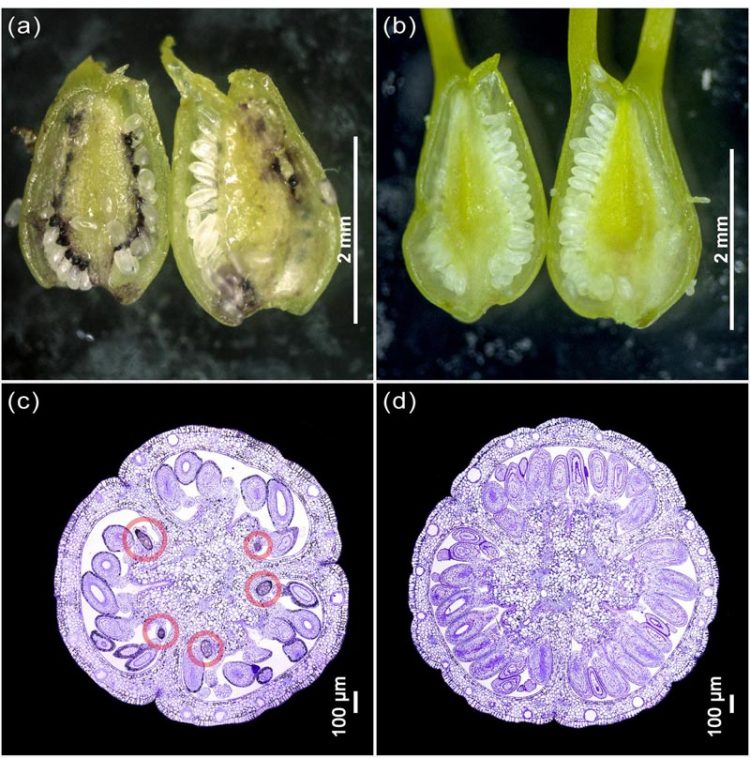Discovery of genes involved in the biosynthesis of antidepressant

A and C: longitudinal and cross section of a pistil bearing dark glands in contrast to; B and D: corresponding sections of a glandless pistil Credit: P. Rizzo / IPK
The herb St John's Wort Hypericum perforatum has a long history as a medicinal plant. Greek physicians of the first century, such as Hippocrates and Pliny, recommended it as a diuretic and as a cure for snakebites, amongst other uses.
In the Middle Ages, it was used in magic potions to ward off evil spirits, whilst Paracelsus in the 16th century found it useful for the alleviation of pain and the treatment of melancholy.
In more recent times, St. John's Wort has been recognised for its applications in cancer therapy, due to the plant's bioactive compound hypericin. Despite its high demand in medical applications, the biosynthetic pathways of hypericin have yet to be fully unveiled.
Recent research focusing on the hypericin-producing dark glands in the flowers of St. John's Wort has now uncovered key regulatory candidate genes for hypericin biosynthesis.
Hypericum perforatum or St. John's Wort is an herbaceous plant with bright yellow flowers and translucent oil glands, giving its leaves a perforated appearance. Originally native to Europe and western Asia, the plant nowadays is found in temperate regions worldwide. Whilst considered a weed which is poisonous to livestock, St. John's Wort is better known for its medicinal properties.
The herb produces several secondary metabolites, of which hypericin counts as one of the most studied. This compound gained an important place in the scientific spotlight due to its potential use in cancer photodynamic therapy and the treatment of the Alzheimer disease.
By focussing on the dark gland development in the flowers, in particular the placental tissue, of St. John's Wort, a collaboration of scientists from German and Canadian research institutes recently discovered some of the key genes potentially involved in the development of dark glands, as well as the biosynthesis of hypericin.
Previous research had often focussed on the leaves of St. John's Wort as the model organ for the study of hypericin. However, by phenotyping 93 Hypericum- accessions, the researchers led by Dr. Paride Rizzo from the Leibniz Institute of Plant Genetics and Crop Plant Research (IPK) in Gatersleben, came across a polymorphism, which showcased glanded and glandless phenotypes in the placental tissue.
By shifting the focus onto the placental tissue of the flowers, the researchers identified two transcription factors involved in the differentiation of dark glands. They further characterised the development of the dark glands within the placental tissue by utilising different microscopy techniques.
These results were achieved through a combination of transcriptomics and metabolomics that provides a view of unprecedented quality on gene expression and metabolites levels during dark gland development in H. perforatum.
First published online in April by the Plant Biotechnology Journal, the findings will now appear in the journal's December print edition. Understanding which genes are involved in the hypericin biosynthesis is a vital step when it comes to the development of new Hypericum extracts for medicinal application.
Having now demonstrated the potential of placental tissue as a new model organ for the study of dark glands and the associated biosynthetic pathways, further research will be able to build upon this knowledge.
In the near future we could expect that these candidate genes will be used to either hyperactivate or inhibit the formation of dark glands. This will lead to new applications of H. perforatum in the pharma industry.
Media Contact
More Information:
http://dx.doi.org/10.1111/pbi.13141All latest news from the category: Life Sciences and Chemistry
Articles and reports from the Life Sciences and chemistry area deal with applied and basic research into modern biology, chemistry and human medicine.
Valuable information can be found on a range of life sciences fields including bacteriology, biochemistry, bionics, bioinformatics, biophysics, biotechnology, genetics, geobotany, human biology, marine biology, microbiology, molecular biology, cellular biology, zoology, bioinorganic chemistry, microchemistry and environmental chemistry.
Newest articles

First-of-its-kind study uses remote sensing to monitor plastic debris in rivers and lakes
Remote sensing creates a cost-effective solution to monitoring plastic pollution. A first-of-its-kind study from researchers at the University of Minnesota Twin Cities shows how remote sensing can help monitor and…

Laser-based artificial neuron mimics nerve cell functions at lightning speed
With a processing speed a billion times faster than nature, chip-based laser neuron could help advance AI tasks such as pattern recognition and sequence prediction. Researchers have developed a laser-based…

Optimising the processing of plastic waste
Just one look in the yellow bin reveals a colourful jumble of different types of plastic. However, the purer and more uniform plastic waste is, the easier it is to…



